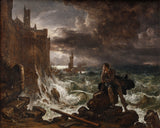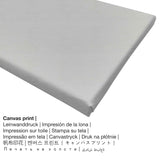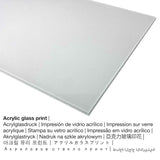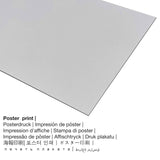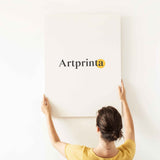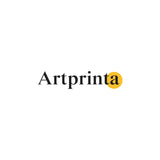Franz Ludwig Catel - Kawałek nocny, z końcowej sceny Renéby'ego Chateaubrianda - grafika artystyczna
Podatek jest wliczony. Koszt wysyłki zostanie obliczony W kasie.
Artwork description from the museum (© Copyright - by Thorvaldsens Museum - Muzeum Thorvaldsenów)
The poet François-René Chateaubriand lived from 1768 to 1848 and became one of the seminal figures of French Romanticism. His René, which appeared in 1802, can be seen as a French counterpart to Goethe’s Die Leiden des Jungen Werther. The title figure René is a passionate melancholic who feels rootless and alien everywhere. He is closely attached only to one person in the world, his sister Amélie. But their love is an incestuous passion which they each try to resist. René considers taking his own life. Amélie enters a convent, and the final scene is played out by the rocky coast, above which rise the convent walls. René has now finally decided to go to America and, while waiting for a passage, walks restlessly around outside the convent. During his last night he writes a sorrowful letter to his sister, as the wind suddenly rises: “I listened, and in the midst of the storm I could distinguish the thunder of the distress signals and the sound of the passing bell in the convent. I hastened down to the beach, where all was deserted, and where only the roar of the waves was to be heard. I sat down on a boulder. On one side, as far as the eye could reach, all that was to be seen were foaming waves; on the other, the dark walls of the convent towered towards heaven. A pale light shone from the barred window. Was it you, my beloved Amélie, kneeling at the foot of the crucifix and praying to the God of the storm to protect your unfortunate brother? The tempest at sea, the peace in your lonely dwelling; folk crushed against the rocks at the foot of your place of refuge, which nothing can disturb; the infinite on the other side of the convent walls; the swinging lanterns on the ships, the immovable lamp in the convent; the uncertain fates of the sailors, the nun who after a single day knows all the coming days in her life … and on the other side a soul like yours, Amélie, as stormy as the sea, a soul that must suffer a more dreadful shipwreck than any sailor.” It is this agonizing farewell scene that Catel portrays in his painting. Catel arrived in Rome in 1811 after studying in Paris, married an Italian woman in 1814 and lived there for the rest of his life.
Informacje o produkcie artystycznym
This painting was made by the male painter Franciszka Ludwika Catela. The artwork was painted with the size of 62,8 cm x 73,8. Olej na płótnie was applied by the German artist as the technique for the work of art. The piece of art is included in the Muzeum Thorvaldsenów kolekcja sztuki. dzięki uprzejmości - Franz Ludwig Catel, Night piece, from the closing scene of "René" by Chateaubriand, , Thorvaldsens Museum, www.thorvaldsensmuseum.dk (licencja domeny publicznej).: . Ponadto trwa dostosowanie reprodukcji cyfrowej krajobraz formacie i ma proporcje obrazu 1.2: 1, which means that the length is 20% longer than the width. Franz Ludwig Catel was a male painter, sculptor, whose artistic style can mainly be assigned to Romanticism. The German artist lived for a total of 78 roku and was born in 1778 in Berlin, Berlin state, Germany and died in 1856 in Rome, Roma province, Lazio, Italy.
Materiały, które możesz wybrać
In the dropdown menu right next to the product you can select a material and a size of your choice. You can choose your preferred material and size among the alternatives:
- Nadruk z dibondu aluminiowego: Aluminium Dibond prints are metal prints with a true effect of depth. A direct Aluminium Dibond Print is your excellent start to fine replicas with alu. The colors are vivid and luminous, fine details of the print appear crisp, and the print has a a matte appearance that you can literally feel.
- Wydruk na płótnie: The canvas print, which should not be confused with a canvas painting, is a digital copy printed from an industrial printer. Additionally, a canvas creates a lovely and positive feeling. Your canvas print of your favorite artpiece will provide you with the chance to turn your fine art print into a large size collection piece like you would see in a gallery. How do I hang a canvas on the wall? Canvas prints are relatively low in weight, meaning that it is quite simple to hang up your Canvas print without extra wall-mounts. Canvas prints are suitable for all types of walls.
- Plakat (materiał płócienny): Połączenia Artprinta poster print is a UV printed canvas paper with a slightly roughened texture on the surface, that reminds the actual work of art. Please bear in mind, that depending on the absolute size of the poster print we add a white margin of approximately 2-6cm round about the work of art to facilitate the framing with a custom frame.
- Nadruk na szkle akrylowym: A glossy print on acrylic glass, which is often labelled as a UV print on plexiglass, will turn the original artwork into beautiful décor. In addition, the acrylic art print is a viable alternative to aluminium or canvas prints.
Tabela podsumowania wykonawców
| Nazwa: | Franciszka Ludwika Catela |
| Znany również jako: | catel f., catel franz, Franz catel, Catel Franz Ludwig, Franz Ludwig Catel |
| Płeć: | zły |
| Narodowość artysty: | niemiecki |
| Oferty pracy: | rzeźbiarz, malarz |
| Kraj pochodzenia: | Niemcy |
| Style sztuki: | Romantyzm |
| Życie: | 78 roku |
| Rok urodzenia: | 1778 |
| Miejsce urodzenia: | Berlin, kraj związkowy Berlin, Niemcy |
| Zmarł w roku: | 1856 |
| Miejsce śmierci: | Rzym, prowincja Roma, Lacjum, Włochy |
Strukturalne szczegóły dzieła sztuki
| Tytuł dzieła: | "Night piece, from the closing scene ofRenéby Chateaubriand" |
| Kategoryzacja dzieła sztuki: | malarstwo |
| Malowane na: | olej na płótnie |
| Oryginalny rozmiar grafiki: | 62,8 cm x 73,8 |
| Wystawiony w: | Muzeum Thorvaldsenów |
| lokalizacja muzeum: | Kopenhaga, Dania |
| strona internetowa muzeum: | Muzeum Thorvaldsenów |
| Licencja grafiki: | domena publiczna |
| Dzięki uprzejmości: | Franz Ludwig Catel, Night piece, from the closing scene of "René" by Chateaubriand, , Thorvaldsens Museum, www.thorvaldsensmuseum.dk |
Ustrukturyzowane szczegóły pozycji
| Rodzaj produktu: | druk artystyczny |
| Reprodukcja: | reprodukcja cyfrowa |
| Technika produkcji: | Druk bezpośredni UV (druk cyfrowy) |
| Produkcja: | Made in Germany |
| Rodzaj akcji: | produkcja na żądanie |
| Przeznaczenie: | galeria ścienna, obraz ścienny |
| Orientacja grafiki: | wyrównanie krajobrazu |
| Format obrazu: | 1.2 : 1 - długość : szerokość |
| Interpretacja: | długość jest o 20% dłuższa niż szerokość |
| Dostępne tkaniny produktu: | wydruk plakatu (papier płócienny), wydruk na płótnie, wydruk w metalu (dibond aluminium), wydruk na szkle akrylowym (z powłoką z prawdziwego szkła) |
| Wydruk na płótnie (płótno na blejtramie) rozmiary: | 60x50cm - 24x20", 120x100cm - 47x39", 180x150cm - 71x59" |
| Warianty wydruku na szkle akrylowym (z powłoką z prawdziwego szkła): | 60x50cm - 24x20", 120x100cm - 47x39" |
| Opcje druku plakatu (papier płócienny): | 60x50cm - 24x20", 120x100cm - 47x39" |
| Rozmiary obrazu Dibond (materiał aluminiowy): | 60x50cm - 24x20", 120x100cm - 47x39" |
| Ramka: | produkt nieoprawiony |
Zastrzeżenia prawne: We try whatever we can in order to describe our products as closely as possible and to exhibit them visually in our shop. However, the colors of the print materials, as well as the imprint might differ marginally from the representation on the device's screen. Depending on your settings of your screen and the condition of the surface, colors can unfortunately not be printed as realistically as the digital version on this website. Since all our are printed and processed manually, there might as well be slight deviations in the size and exact position of the motif.
© Ochrona praw autorskich - Artprinta (www.artprinta.com)

